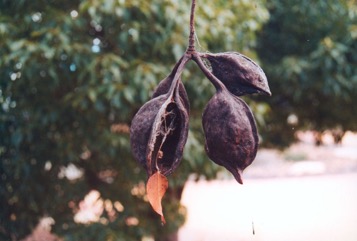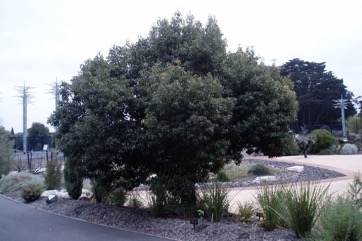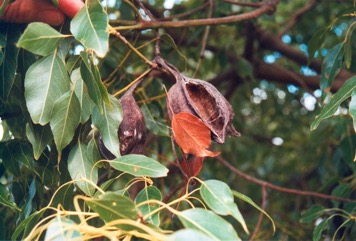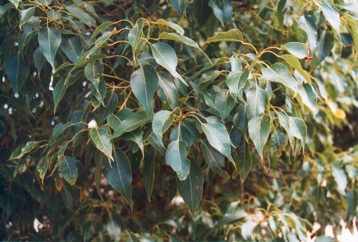Black kurrajong

A tropical plant. It is native to E. Australia. It grows in temperate and semiarid places. It will grow in a range of soil and climate conditions. It grows naturally on rocky hillsides. It needs well-drained soil. It will grow on limestone soils. It can stand heavy frosts. It can grow in coastal conditions. It grows in areas with an annual rainfall between 300-880 mm. It grows between 200-780 m above sea level. It can grow in arid places. In the Inland Botanical Gardens Mildura. It suits hardiness zones 8-11.
Also known as:
Nangkata, Nhimin, Nhungga, Plameneče drevo
Synonyms
- Clompanus diversifolia (G. Don) Kuntze
- Clompanus gregorii Kuntze
- Sterculia diversifolius G. Don
- Brachychiton diversifolius var. muelleri
- Poecilodermis populnea Schott. & Endl.
Edible Portion
- Seeds, Gum, Roots, Sap, Seeds - coffee, Leaves
Where does Black kurrajong grow?
Found in: Africa, Asia, Australia, Chile, China, East Africa, Egypt, France, Iraq, Kenya, Lebanon, Malawi, Mozambique, North Africa, North America, Pakistan, Slovenia, Somalia, South Africa, Southern Africa, Sudan, Taiwan, Tanzania, Turkey, United States, Zambia, Zimbabwe
Notes: The leaves are often used to feed animals in dry seasons. There are about 30 Brachychiton species. Most are in Australia. Also put in the family Sterculiaceae.
Growing Black kurrajong
Cultivation: Plants can be grown from seed. Young plants can be transplanted easily.
Edible Uses: Caution. The fine irritant hairs need to be removed during harvesting. The seeds are eaten raw or roasted. They can be ground into flour and used for dampers or scones. They are also made into a coffee-like drink. They are roasted and ground then used to brew coffee. The young roots are boiled and eaten.
Nutrition Info
per 100g edible portion| Edible Part | Energy (kcal) | Protein (g) | Iron (mg) | Vitamin A (ug) | Vitamin c (mg) | Zinc (mg) | % Water |
|---|---|---|---|---|---|---|---|
| Seed | 348 | 18.1 | 2.1 | - | - | 5.4 | 5.6 |
| Roots | - | - | - | - | - | - | |
| Sap | - | - | - | - | - | - |
Black kurrajong Photos




References
Anon., 2003, Native Plants for the Fitzroy basin. Society for Growing Australian Plants Inc. (Rockhampton Branch)
Barwick, M., 2004, Tropical and Subtropical Trees. A Worldwide Encyclopedic Guide. Thames and Hudson p 58
J. J. Bennett & R. Brown, Pl. jav. rar. 234. 1844
Bircher, A. G. & Bircher, W. H., 2000, Encyclopedia of Fruit Trees and Edible Flowering Plants in Egypt and the Subtropics. AUC Press. p 63
Bodkin, F., 1991, Encyclopedia Botanica. Cornstalk publishing, p 164 (Also as Brachychiton populneus subsp. populneus)
Brickell, C. (Ed.), 1999, The Royal Horticultural Society A-Z Encyclopedia of Garden Plants. Convent Garden Books. p 186
Caton, J.M. & Hardwick, R. J., 2016, Field Guide to Useful Native Plants from Temperate Australia. Harbour Publishing House. p 330
Cherikoff V. & Isaacs, J., The Bush Food Handbook. How to gather, grow, process and cook Australian Wild Foods. Ti Tree Press, Australia p 57, 194 Also p 189 (As Brachychiton populneus subsp. populneus)
Cribb, A.B. & J.W., 1976, Wild Food in Australia, Fontana. p 81, 138, 173
Cronin, L., 1989, The Concise Australian Flora. Reed. p 170 (As Brachychiton populneus subsp. populneus)
Cundall, P., (ed.), 2004, Gardening Australia: flora: the gardener's bible. ABC Books. p 250
Edible and Useful Native Plants (off internet)
Elliot, W.R., & Jones, D.L., 1982, Encyclopedia of Australian Plants suitable for cultivation. Vol 2. Lothian. p 366 (As Brachychiton populneus subsp. populneus)
Etherington, K., & Imwold, D., (Eds), 2001, Botanica's Trees & Shrubs. The illustrated A-Z of over 8500 trees and shrubs. Random House, Australia. p 139
Flora of Pakistan. www.eFloras.org (As populneum)
Gen. hist. 1:516. 1831 (As Sterculia diversifolia G. Don)
Hardwick, R.J., 2000, Nature's Larder. A Field Guide to the Native Food Plants of the NSW South Coast. Homosapien Books. p 75
Hall, N. et al, 1972, The Use of Trees and Shrubs in the Dry Country of Australia, AGPS, Canberra. p 355
Hearne, D.A., & Rance, S.J., 1975, Trees for Darwin and Northern Australia. AGPS, Canberra p 35, Pl 10
Hedrick, U.P., 1919, (Ed.), Sturtevant's edible plants of the world. p 634 (As Sterculia diversifolia G. Don)
Hibbert, M., 2002, The Aussie Plant Finder 2002, Florilegium. p 45
Holliday, I., 1989, A Field Guide to Australian Trees. Hamlyn. p 82
Hunter, J. T. & Sheringham, P., 2006, Vegetation and Floristics of Melville Range Nature Reserve. A Report to the New South Wales Parks and Wildlife Service. p 165
Hunter, J., 2015, Vegetation and flora of Naree and Yantabulla. A Draft Report to the Bush Heritage Australia
Hunter, J.T., 2017, Is there a relationship between contemporary high Aboriginal plant resource locations and mapped vegetation communities? Cunninghamia 17:27-34. The Royal Botanic Garden Sydney. ISSN 2200 - 405X
Hussey, B.M.J., Keighery, G.J., Cousens, R.D., Dodd, J., Lloyd, S.G., 1997, Western Weeds. A guide to the weeds of Western Australia. Plant Protection Society of Western Australia. p 224 (As Brachychiton populneus subsp. populneus)
Lazarides, M. & Hince, B., 1993, Handbook of Economic Plants of Australia, CSIRO. p 36 (As Brachychiton populneus subsp. populneus)
Lim, T. K., 2015, Edible Medicinal and Non Medicinal Plants. Volume 9, Modified Stems, Roots, Bulbs. Springer p 17
Lord, E.E., & Willis, J.H., 1999, Shrubs and Trees for Australian gardens. Lothian. p 13 (As Brachychiton populneus subsp. populneus)
Low, T., 1991, Wild Food Plants of Australia. Australian Nature FieldGuide, Angus & Robertson. p 183 (As Brachychiton populneus subsp. populneus)
Low, T., 1992, Bush Tucker. Australia’s Wild Food Harvest. Angus & Robertson. p 27, 87 (As Brachychiton populneus subsp. populneus)
McKerney, M. & White, H., 2011, Bush Tucker, Boomerangs & Bandages. Border River-Gwyder Catchment Management Authority p 71
Menninger, E.A., 1977, Edible Nuts of the World. Horticultural Books. Florida p 43 (As Sterculia diversifolia G. Don)
Molyneux, B & Forrester, S., 1997, The Austraflora A-Z of Australian Plants. Reed. p 57
Nash, D., 2004, Aboriginal Plant Use in south-eastern Australia. Australian National Botanic Gardens. p 9
Paczkowska, G . & Chapman, A.R., 2000, The Western Australian Flora. A Descriptive Catalogue. Western Australian Herbarium. p 538
Plants for a Future database, The Field, Penpol, Lostwithiel, Cornwall, PL22 0NG, UK. http://www.scs.leeds.ac.uk/pfaf/ (As Brachychiton populneus subsp. populneus)
Recher, P, 2001, Fruit Spirit Botanical Gardens Plant Index. www.nrg.com.au/~recher/ seedlist.html p 1
Robins, J., 1996, Wild Lime. Cooking from the Bush food garden. Allen & Unwin p 172 (As Brachychiton populneus subsp. populneus)
Royal Botanic Gardens, Kew (1999). Survey of Economic Plants for Arid and Semi-Arid Lands (SEPASAL) database. Published on the Internet; http://www.rbgkew.org.uk/ceb/sepasal/internet [Accessed 11th June 2011]
Ryan, M. (Ed.), 2003, Wild Plants of Greater Brisbane. Queensland Museum. p 136
Self, M., 199, Phoenix Seeds catalogue. p 16 (As Brachychiton populneus subsp. populneus)
Steenbeeke, Greg as part of the Plants Directory project. List of plant species from northern NSW that may be used as food plants p 11
Townsend, K., 1994, Across the Top. Gardening with Australian Plants in the tropics. Society for Growing Australian Plants, Townsville Branch Inc. p 105
Wickens, G.E., 1995, Edible Nuts. FAO Non-wood forest products. FAO, Rome. p155 (As Sterculia diversifolia G. Don)
Williams, J.B., Harden, G.J., and McDonald, W.J.F., 1984, Trees and shrubs in rainforests of New South Wales and Southern Queensland. Univ. of New England, Armidale. p 62
Williams, J.B., Harden, G.J., and McDonald, W.J.F., 1984, Trees and shrubs in rainforests of New South Wales and Southern Queensland. Univ. of New England, Armidale. p 98 (As Brachychiton populneus subsp. populneus)
Williams, K.A.W., 1999, Native Plants of Queensland Volume 4. Keith A.W. Williams North Ipswich, Australia. p 78
Williams A. & Sides, T., 2008, Wiradjuri Plant Use in the Murrumbidgee Catchment. Murrumbidgee Catchment Management Authority. Wagga Wagga, p 23
www.ceres.org/au/bushfood catalogue
Young, J., (Ed.), 2001, Botanica's Pocket Trees and Shrubs. Random House. p 146
Zola, N., & Gott, B., 1992, Koorie Plants Koorie People. Koorie Heritage Trust. p 36